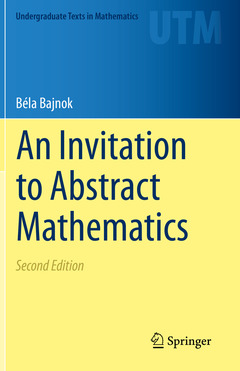Description
An Invitation to Abstract Mathematics (2nd Ed., 2nd ed. 2020)
Undergraduate Texts in Mathematics Series
Author: Bajnok Béla
Language: English
Subjects for An Invitation to Abstract Mathematics:
Keywords
Abstract mathematics textbook; Abstract mathematics game; Abstract mathematics problems; Hackenbush game; Nim game; Fundamental theorem of arithmetic; Primitives mathematics; Higher mathematics transition; Transition to higher mathematics; Math statement proof; Mathematical induction; Parallel postulate; Axiom of choice; Fundamental theorem of equivalence relations; Generalized continuum hypothesis; Hungarian approach mathematics
Publication date: 10-2021
442 p. · 15.5x23.5 cm · Paperback
Publication date: 10-2020
442 p. · 15.5x23.5 cm · Hardback
Description
/li>Contents
/li>Biography
/li>Comment
/li>
This undergraduate textbook promotes an active transition to higher mathematics. Problem solving is the heart and soul of this book: each problem is carefully chosen to demonstrate, elucidate, or extend a concept. More than 300 exercises engage the reader in extensive arguments and creative approaches, while exploring connections between fundamental mathematical topics.
Divided into four parts, this book begins with a playful exploration of the building blocks of mathematics, such as definitions, axioms, and proofs. A study of the fundamental concepts of logic, sets, and functions follows, before focus turns to methods of proof. Having covered the core of a transition course, the author goes on to present a selection of advanced topics that offer opportunities for extension or further study. Throughout, appendices touch on historical perspectives, current trends, and open questions, showing mathematics as a vibrant and dynamic human enterprise.
This second edition has been reorganized to better reflect the layout and curriculum of standard transition courses. It also features recent developments and improved appendices. An Invitation to Abstract Mathematics is ideal for those seeking a challenging and engaging transition to advanced mathematics, and will appeal to both undergraduates majoring in mathematics, as well as non-math majors interested in exploring higher-level concepts.
From reviews of the first edition:
Bajnok?s new book truly invites students to enjoy the beauty, power, and challenge of abstract mathematics. ? The book can be used as a text for traditional transition or structure courses ? but since Bajnok invites all students, not just mathematics majors, to enjoy the subject, he assumes very little background knowledge.Jill Dietz, MAA ReviewsThe style of writing is careful, but joyously enthusiastic?. The author?s clear attitude is that mathematics consists of problem solving, and that writing a proof falls into this category. Students of mathematics are, therefore, engaged in problem solving, and should be given problems to solve, rather than problems to imitate. The author attributes this approach to his Hungarian background ? and encourages students to embrace the challenge in the same way an athlete engages in vigorous practice.John Perry, zbMATH
Béla Bajnok is a Professor of Mathematics at Gettysburg College, where he received the Excellence in Teaching Award; he is also the recipient of the Mathematical Association of America’s Crawford Award for Distinguished College or University Teaching. He is a native of Hungary, and he remains greatly influenced by the approach to mathematics instilled during his education there. He is on the Board of the Budapest Semesters in Mathematics, and is the Director of the American Mathematics Competitions program of the MAA.
Motivates readers to understand the connections between different concepts when transitioning to higher mathematics
Encourages creative and analytical approaches to solving numerous, carefully chosen problems
Illustrates the many ways in which mathematics is a vibrant human enterprise by exploring historical perspectives, current trends, and open questions




